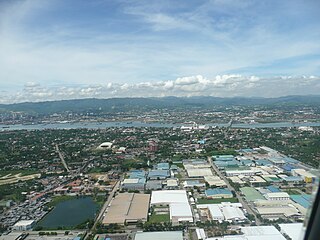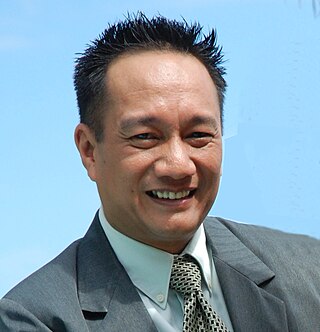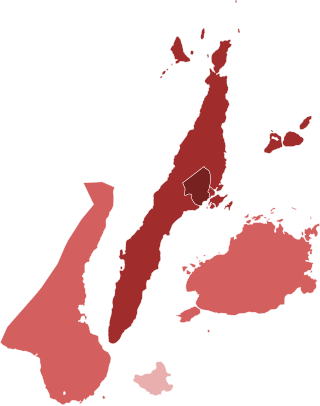Related Research Articles

Transportation in the Philippines covers the transportation methods within this archipelagic nation of over 7,500 islands. From a previously underdeveloped state of transportation, the government of the Philippines has been improving transportation through various direct infrastructure projects, and these include an increase in air, sea, road, and rail transportation and transport hubs.

Cebu City, officially the City of Cebu, is a 1st class highly urbanized city in the Central Visayas region of the Philippines. It is the capital of the Cebu Province, where it is geographically located but is one of three cities that are administratively independent of the provincial government. According to the 2020 census, it has a population of 964,169 people, making it the sixth-most populated city in the nation and the most populous in the Visayas.

Lapu-Lapu City, officially the City of Lapu-Lapu, is a 1st class highly urbanized city in the Central Visayas region of the Philippines. According to the 2020 census, it has a population of 497,604 people.

A motorcycle taxi, or cart bike or bike taxi, is a licensed form of transport in some countries. The taxi typically carries one passenger, who "rides pillion" behind the motorcycle operator. Multiple passengers are common in some countries.

Ahmed G. Cuizon is a media practitioner in Cebu Philippines.

The Cebu Bus Rapid Transit System is a mass transit system under construction in Cebu City, Philippines. It is expected to become the first operational bus rapid transit project in the Philippines. Only one line has been planned in detail so far, but scheme developers note the potential to develop a larger network comprising the adjacent cities of Lapu-Lapu, Mandaue, and Talisay, all of which, together with Cebu City, form part of the Cebu metropolitan area.

Nigel Paul C. Villarete is a Filipino civil engineer and urban planner. He was the general manager of Mactan–Cebu International Airport and the chief executive officer of the Mactan–Cebu International Airport Authority (MCIAA) from October 26, 2010 to December 31, 2016.
Fil-Asian Airways, formerly Mid-Sea Express, was a Cebu-based airline with AOC issued by CAAP. It was formed in 2011 and ceased operating in 2014. Mid-Sea Express started as air charter operator and non-scheduled air taxi headquartered at Mactan–Cebu International Airport in Lapu-Lapu City in Central Visayas, in the Philippines. As Fil-Asian Airways, its slogan was "The Asian experience". The airline was operated from major airports such as Mactan–Cebu International Airport in Cebu, Francisco Bangoy International Airport in Davao City and Zamboanga International Airport.

The Cebu–Cordova Link Expressway (CCLEX), also known as the Cebu–Cordova Bridge and the Third Cebu–Mactan Bridge, is an 8.9-kilometer (5.5 mi) toll bridge expressway in Metro Cebu, Philippines. The bridge connects the South Road Properties in Cebu City in mainland Cebu, and Cordova, on Mactan island. Crossing the Mactan Channel, it is the third road link between Cebu and Mactan islands, and the first between Cebu City and Cordova. It is the longest sea-crossing bridge in the Philippines, surpassing the 2-kilometer (1.2 mi) San Juanico Bridge between Samar and Leyte, as well as Marcelo Fernan Bridge as the longest cable-stayed bridge in the Philippines. It also surpassed the 5-kilometer (3.1 mi) Candaba Viaduct of North Luzon Expressway (NLEX) connecting the provinces of Pampanga and Bulacan for being the longest bridge in the Philippines overall upon its inauguration on April 27, 2022.

Mactan–Cebu International Airport is an international airport serving Cebu and serves as the main gateway to the Central Visayas region in the Philippines. Located on a 797-hectare (1,970-acre) site in Lapu-Lapu City on Mactan, it is the second busiest airport in the Philippines. The airport serves as a hub for Cebu Pacific and Philippine Airlines, and as an operating base for Philippines AirAsia.

Edgardo Colina Labella was a Filipino politician and lawyer who served as the mayor of Cebu City from 2019 until his death in 2021. Prior to becoming mayor, he was the city's vice mayor from 2013 to 2019 and was a member of the Cebu City Council from 1998 to 2001 and again from 2004 to 2013.
DBDOYC Inc., doing business as Angkas, is a Philippine motorcycle vehicle for hire and package delivery company based in Makati, Metro Manila.

Partido Barug, commonly known as BARUG, is a regional political party based in Cebu City, Philippines. Cebu City mayor Michael Rama is its founding president.

Tuslob buwa is a Cebuano street food which originated from the barangays of Pasil and Suba in Cebu City.

The COVID-19 pandemic in Central Visayas is part of the worldwide pandemic of coronavirus disease 2019 caused by severe acute respiratory syndrome coronavirus 2. The virus reached Central Visayas on February 5, 2020, when the first case of the disease was confirmed in Bohol. As of May 2, 2023, there have been 210,549 cases in Central Visayas with 6,685 deaths.
The Pasil Fish Market is a major fish market located in Barangay Suba, Cebu City, Philippines. Established in 1921, the market is a major market for fresh fish sourced throughout the seas of Visayas, such as Visayan Sea, Samar Sea, Camotes Sea, and Bohol Strait, among others.
The Cebu South Bus Terminal (CSBT) is a bus station in Cebu City, Philippines. CSBT is operated by the Cebu Provincial Government with Carmen Quijano as its current operations manager. The station is a hub for buses servicing southern Cebu and nearby provinces such as Negros Oriental, Negros Occidental and the Zamboanga Peninsula.
The Cebu North Bus Terminal (CNBT) is a bus station in Cebu City, Philippines operated by the Cebu Provincial Government which serves as a hub for buses servicing northern Cebu. CNBT was previously located in a lot owned by the Mandaue city government in Barangay Subangdaku which was under a lease agreement with Cebu City government, which in turn granted the Cebu Provincial Bus Operators Multi-purpose Cooperative, Inc. (CPBOMCI) the management of the terminal.

Bagong Jeep, also known as the Bagong Jeepney, is a public transport service which maintains a fleet of minibuses and vans which are characterized as jeepneys.
References
- ↑ "LTFRB Functions". ltfrb.gov.ph. LTFRB. Retrieved 2019-09-21.
- 1 2 "Cebu City Philippines, Getting There, Tourist Travel General Info". mycebuguide.com. My Cebu Guide. Retrieved 2019-09-21.
- ↑ Gerard Vincent Francisco, Morexette Marie B. Erram (2018-12-20). "'Beeps' to start plying Cebu City's streets on Saturday". CDN Digital. Retrieved 2019-09-21.
- ↑ Delta Dyrecka Letigio (16 November 2019). "Councilor Gabuya to CCTO: Designate proper BEEP stops". CDN Digital. Retrieved 6 December 2019.
- ↑ "Free rides on 15 'peoples jeep' units in 3 Cebu routes for two months". SunStar Cebu. Retrieved 2019-09-21.
- ↑ Rosalie Abatayo (2019-07-31). "Governor Garcia: A more beautiful Cebu South Bus Terminal soon". CDN Digital. Retrieved 2019-09-21.
- ↑ Michelle Joy L. Padayhag (2015-11-12). "Want to ride MyBus?". CDN Digital. Retrieved 2019-09-21.
- ↑ Aileen Garcia-Yap (2015-12-29). "MyBus starts Mactan airport to SM City Cebu route". CDN Digital. Retrieved 2019-09-21.
- ↑ "About myBus". mybus.ph. MyBus. Retrieved 2019-09-21.
- ↑ Jessa Mae O. Sotto (2018-03-01). "More than 400 taxis adjust meters". CDN Digital. Retrieved 2019-09-21.
- ↑ Mitchelle L. Palaubsanon (2018-03-15). "1,600 Cebu taxis adjust meters". The Freeman. Retrieved 2019-09-21.
- ↑ "Cebuanos Get the Freedom to Choose with GrabCar". grab.com/ph. Grab PH. Retrieved 2019-09-21.
- ↑ Charles R. Pepito (2017-09-27). "Taxi app Micab launched in Cebu". BusinessMirror. Retrieved 2019-09-21.
- ↑ Atty. Ruphil Bañoc. "Where are you going Angkas/habal-habal?". cebudailynews.inquirer.net. CDN Digital. Retrieved 2019-09-21.
- ↑ Marc Eric Cosep. "Angkas, anyone?". cebudailynews.inquirer.net. CDN Digital. Retrieved 2019-09-21.
- ↑ Jose Santino S. Bunachita, Michelle Joy L. Padayhag (2017-07-31). "LTO-7 warns against 'colorum' operation of motorcycles-for-hire". CDN Digital. Retrieved 2019-09-21.
- ↑ Jean Marvette A. Demecillo (2019-04-05). "HabalHabal operations city government files petition questioning SC's TRO". The Freeman. Retrieved 2019-09-21.
- ↑ "Cebu City mayor to organize 6,000 habal-habal drivers". SunStar Cebu. 2018-10-28. Retrieved 2019-09-21.
- ↑ Christia Marie Ramos (2019-07-01). "First House bills filed under 18th Congress tackle FOI, motorcycle regulation, HRDs, Cebu development". Philippine Daily Inquirer. Retrieved 2019-09-21.
- ↑ Delta Dyrecka Letigio (2019-09-06). "Labella supports ordinance regulating habal-habal drivers". CDN Digital. Retrieved 2019-09-21.
- ↑ Isabella G. Obor (2018-12-22). "Tartanillas to ply city streets soon". The Freeman. Retrieved 2019-09-21.
- ↑ "Tartanilla Cebu's fading chariots". CDN Digital. 2018-08-17. Retrieved 2019-09-21.
- ↑ "LTO to seize e-bikes seen on city streets". SunStar Cebu. 2019-07-18. Retrieved 2019-09-21.
- ↑ "Transportation: Trisikad in Cebu". onecebu.com. Retrieved 2019-09-21.
- ↑ Delta Dyrecka Letigio (2018-09-04). "P66M in fines collected from traffic violators". CDN Digital. Retrieved 2019-09-21.
- ↑ Victorina Zosa (August 2004). "Philippine – Japan Economic Linkages: A Case Study of Cebu" (PDF). Discussion Paper Series No. 2004-33. Philippine Institute for Development Studies. Retrieved 2019-09-21.
- ↑ Jose Santino S. Bunachita, Michelle Joy L. Padayhag, Nestle L. Semilla, Vanessa Lucero & Victor Anthony V. Silva (2016-02-09). "LET'S DO FERRY". CDN Digital. Retrieved 2019-09-21.
{{cite news}}: CS1 maint: multiple names: authors list (link) - ↑ Fe Marie D. Dumaboc (2018-08-08). "Two ferry boats to decongest Lapu-Lapu City traffic". CDN Digital. Retrieved 2019-09-21.
- ↑ "2 new passenger vessels ply Mactan-Cebu route". SunStar Cebu. 2018-12-12. Retrieved 2019-09-21.
- ↑ "Built for typhoons, the Philippines' longest and tallest bridge opens today". Global Construction Review. Metro Cebu. April 27, 2022. Retrieved April 27, 2022.